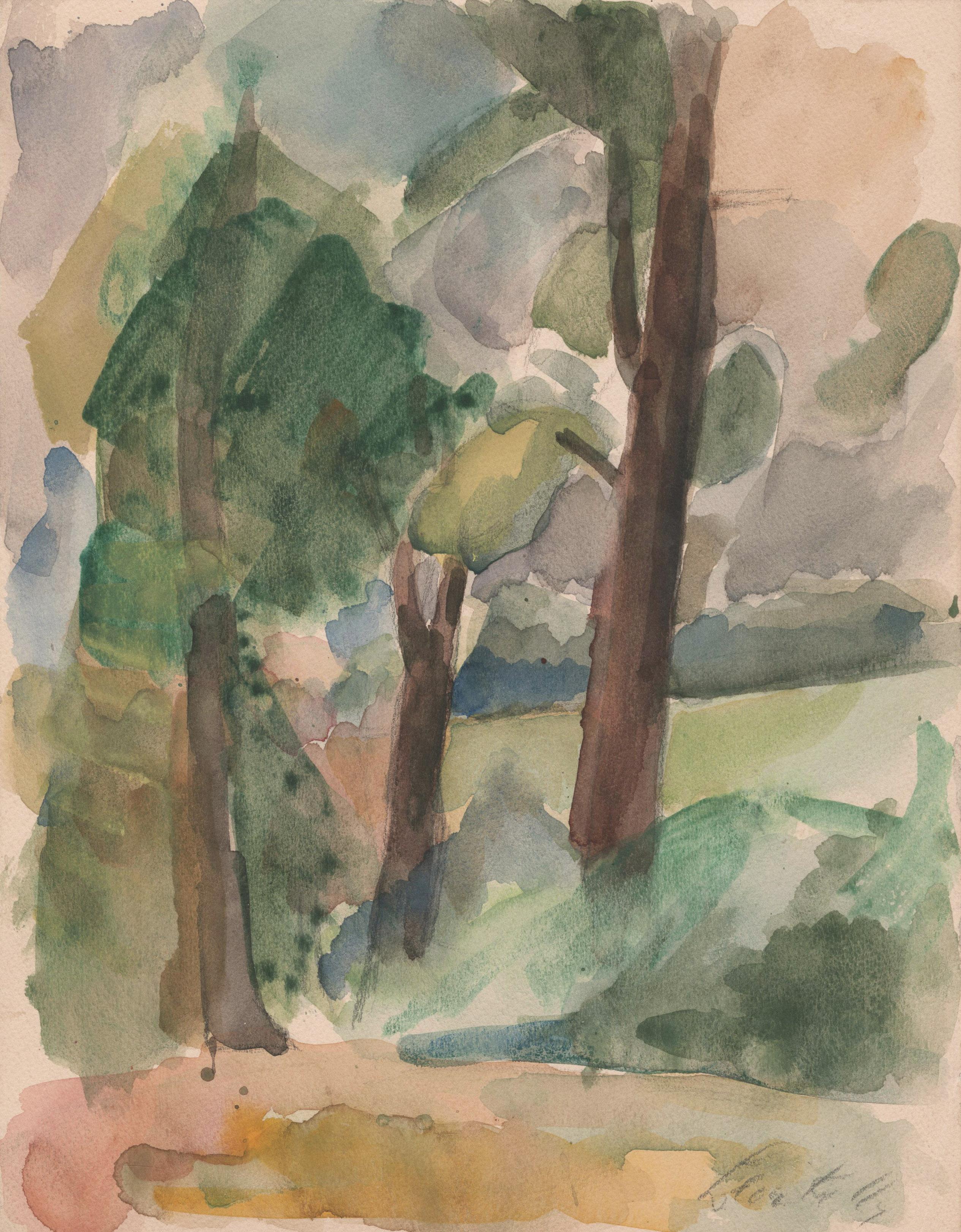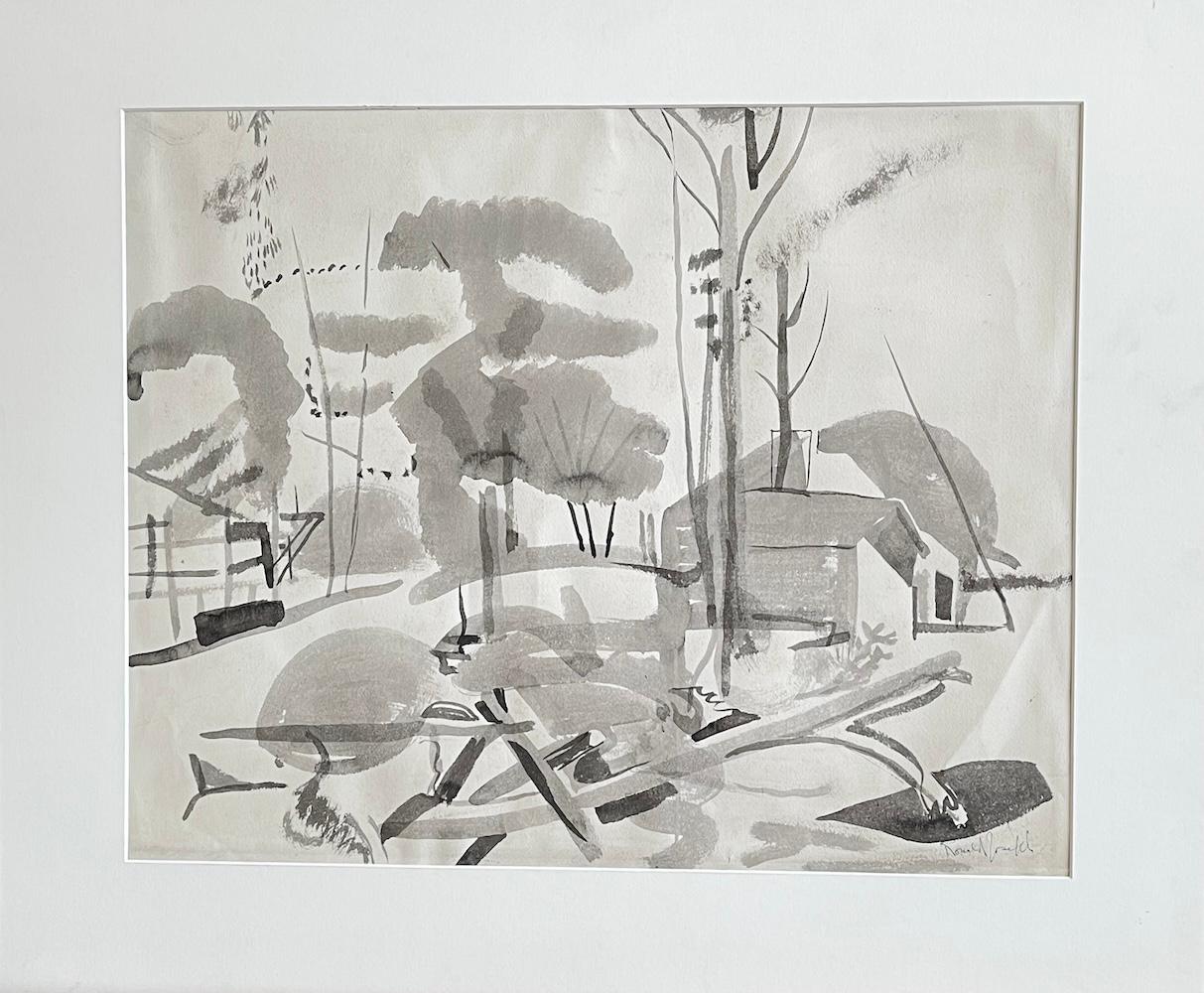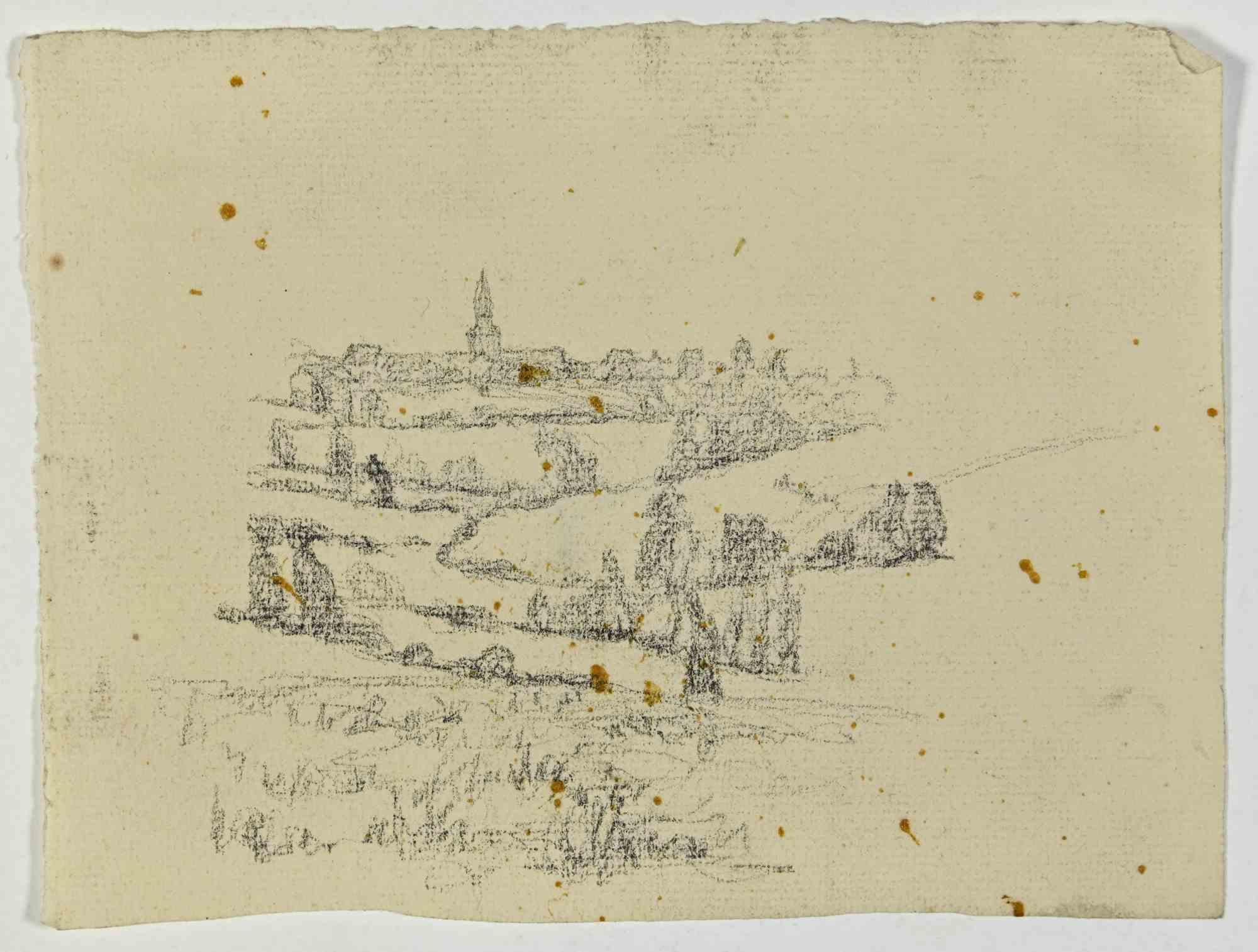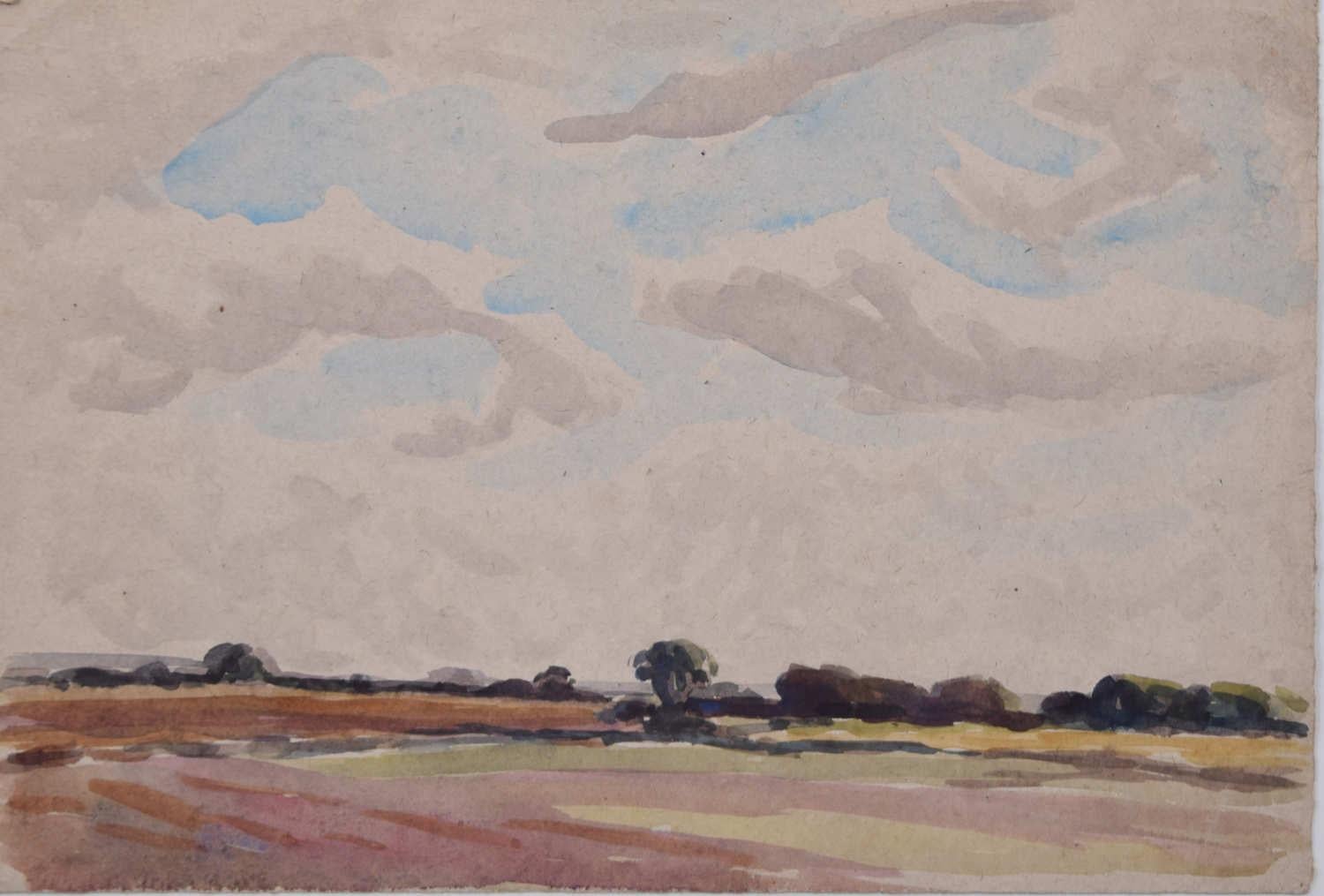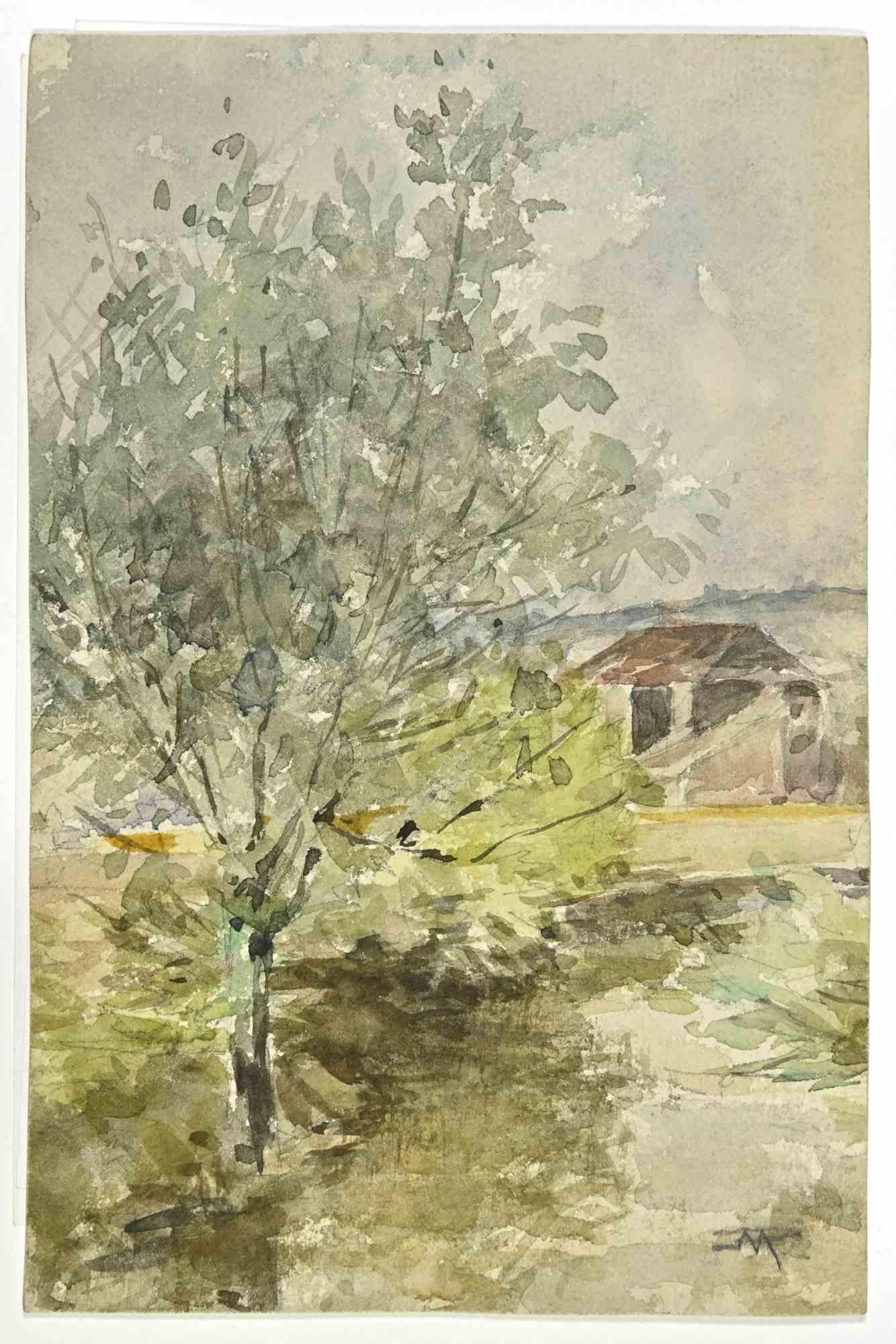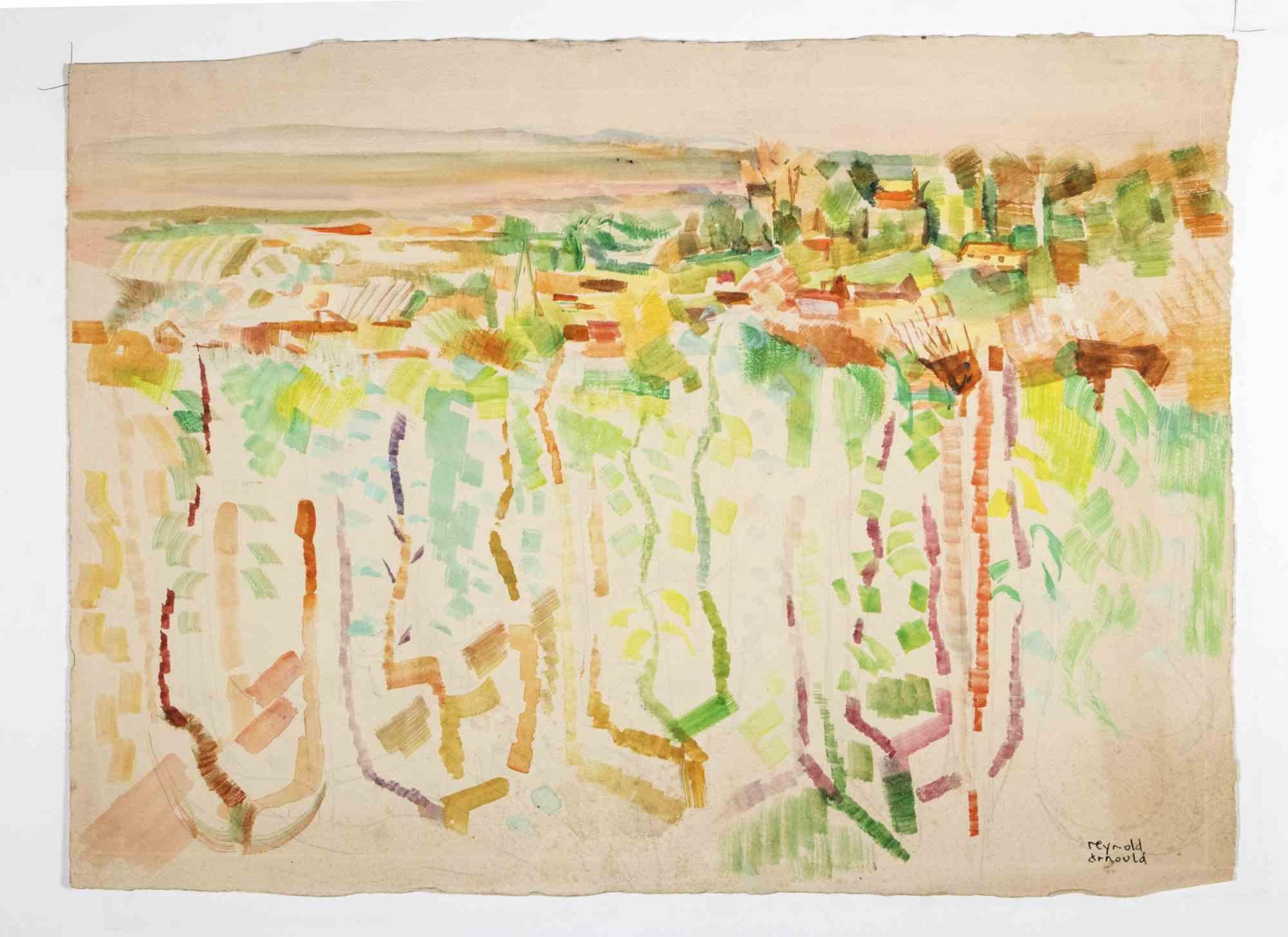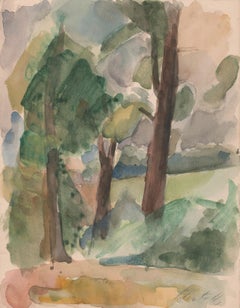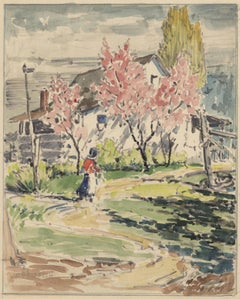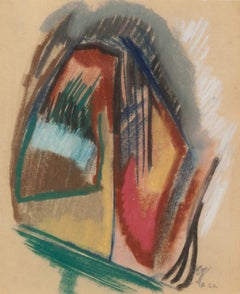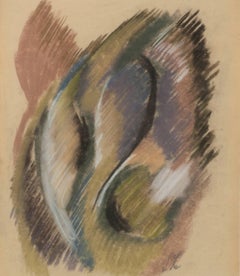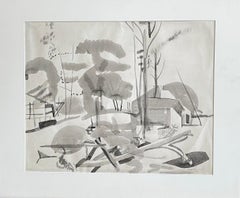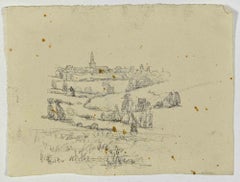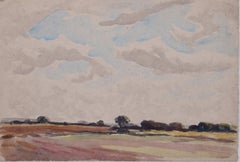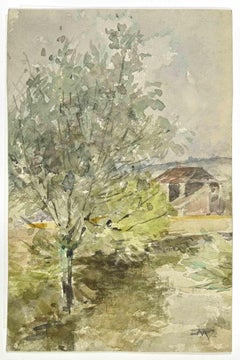Items Similar to Landscape with buildings and trees
Want more images or videos?
Request additional images or videos from the seller
1 of 7
Leon KellyLandscape with buildings and trees1930's
1930's
$2,750
£2,115.48
€2,455.47
CA$3,878.16
A$4,344.19
CHF 2,281.72
MX$52,823.93
NOK 28,894.08
SEK 27,428.25
DKK 18,326.16
About the Item
Landscape with buildings and trees
Watercolor on paper, c. 1930's
Signed in pencil lower right (see photo)
Provenance: Estate of the artist
Condition: Excellent
Sheet size: 9 3/8 x 11 inches
Most probably and American scene asfter his return from Paris in late 1929.
Leon Kelly (From Wikipedia, the free encyclopedia)
Leon Kelly (October 21, 1901 – June 28, 1982) was an American artist born in Philadelphia, PA. He is most well known for his contributions to American Surrealism, but his work also encompassed styles such as Cubism, Social Realism, and Abstraction. Reclusive by nature, a character trait that became more exaggerated in the 1940s and later, Kelly's work reflects his determination not to be limited by the trends of his time. His large output of paintings is complemented by a prolific number of drawings that span his career of 50 years. Some of the collections where his work is represented are: The Metropolitan Museum in New York, The Whitney Museum of American Art, the Museum of Modern Art, the Philadelphia Museum of Art, and Boston Public Library.
Biography
Kelly was born in 1901 at home at 1533 Newkirk Street, Philadelphia, PA. He was the only child of Elizabeth (née Stevenson) and Pantaleon L. Kelly. The family resided in Philadelphia where Pantaleon and two of his cousins owned Kelly Brothers, a successful tailoring business. The prosperity of the firm enabled his father to purchase a 144-acre farm in Bucks County PA in 1902, which he named "Rural Retreat" It was here that Pantaleon took Leon to spend every weekend away from the pressures of business and from the disappointments in his failing marriage. Idyllic and peaceful memories of the farm stayed with Leon and embued his work with a love of nature that emerged later in the Lunar Series, in Return and Departure, and in the insect imagery of his Surrealist work. "If anything," he once said,"I am a Pantheist and see a spirit in everything, the grass, the rocks, everything."
At thirteen, Leon left school and began private painting lessons with Albert Jean Adolphe, a teacher at the School of Industrial Art (now the University of the Arts) in Philadelphia. He learned technique by copying the works of the old masters and visiting the Philadelphia Zoo, where he would draw animals. Drawings done in 1916 and 1917 of elephants, snakes and antelope, as well as copies of old master paintings by Holbein and Michelangelo, heralded an impressive emerging talent. In 1917, he studied sculpture with Alexander Portnoff but his studies came to an abrupt halt with the start of World War I. Being too young to enlist, he joined the Quartermaster Corp at the Army Depot in Philadelphia, where he served for more than a year loading ships with supplies and, along with other artists, working on drawings for camouflage.
By 1920, the family's fortunes drastically changed. His father's business had failed due to the introduction of ready made clothing and his marriage, unhappy from the beginning, dissolved. Broken by circumstance Pantaleon left Philadelphia to begin a wandering existence looking for work leaving Leon to support his mother and grandmother. He found a job in 1920 at the Freihofer Baking Company where he worked nights for the next four years. Under these circumstances Leon continued to develop his skills in drawing and painting and learned of the revolutionary developments in art that were taking place in Paris.
During the day he was granted permission to study anatomy at the Philadelphia School of Osteopathy where he dissected a cadaver and perfected his knowledge of the human figure. He also met and studied etching with Earl Horter, a well known illustrator, who had amassed a significant collection of modern art which included work by Brancusi, Matisse, and Cubist works by Picasso and Braque. Among the artists around Horter was Arthur Carles, a charismatic and controversial painter who taught at the Pennsylvania Academy of Fine Arts. Leon enrolled in the Academy in 1922, becoming what Carles described as, "his best student".
In the next three years Leon work ranged from academic studies of plaster casts, to pointillism, to landscapes of Fairmount Park in Philadelphia, as well as a series of pastels showing influences from Matisse to Picasso. Clearly influenced by Earl Horter's collection and Arthur Carles he mastered analytical cubism in works such as The Three Pears, 1923 and 1925 experimented with Purism in Moon Behind the Italian House. In 1925 Kelly was awarded a Cresson Scholarship and on June 14 he left for Europe.
Paris
The first trip to Europe lasted for approximately three and a half months and introduced Kelly to a culture and place where he felt he belonged. Though he returned to the Academy in the Fall, he left for Europe again a few months later to begin a four-year stay in Paris. He moved into an apartment at 19 rue Daguerre in Paris and began an existence intellectually rich but in creature comforts, very poor. "I kept a cinderblock over the drain in the kitchen sink to keep the rats out of the apartment" he once explained. He frequented the cafes making acquaintances with Henry Miller, James Joyce and the critic Félix Fénéon as well as others. His days were split between copying old master paintings in the Louvre and pursuing modernist ideas that were swirling through the work of all the artists around him. The Lake, 1926 and Interior of the Studio, 1927, now in the Newark Museum.
Patrons during this time were the police official Leon Zamaran, a collector of Courbets, Lautrecs and others, who began collecting Kelly's work. Another was Alfred Barnes of the Barnes Collection in Philadelphia.
In 1929 Kelly married a young French woman, Henriette D'Erfurth. She appears frequently in paintings and drawings done between 1928 and the early 1930s.
Philadelphia
The stock market crash of 1929 made it impossible to continue living in Paris and Kelly and Henriette returned to Philadelphia in 1930. He rented a studio on Thompson Street and began working and participating in shows in the city's galleries. Work from 1930 to 1940 showed continuing influences and experimentation with the themes and techniques acquired in Paris as well as a brief foray into Social Realism. The Little Gallery of Contemporary Art purchased the Absinthe Drinker in 1931 and in 1932 exhibited Judgement of Paris, 1932, an ambitious painting with a classical theme. In October 1934, "Interior of a Slaughter House" and several other works were included in "Second Regional Exhibition of Painting and Prints by Philadelphia Artists" at the Whitney Museum in New York.
Kelly joined the Philadelphia Public Works of Art Project and worked on sketches for a mural destined for the School Administration Building. While some sketches survived, one is in the Metropolitan, the mural is lost. The harsh financial conditions of Kelly's life continued and by the late 1930s, Henriette, who spoke no English and whose only companionship outside the home was Helen Lloyd Horter (who spoke French), returned to France permanently When his divorce was finalized, Kelly began seeing Helen Lloyd Horter, a Philadelphia painter and a fellow student at the Academy and who was now the ex-wife of Earl Horter. In 1941 they married.
Kelly continued to work in his studio on Brandywine Street in Philadelphia teaching small classes to gain some income. Kelly's study of the masters in the Louvre collection resulted in great admiration for the Renaissance painter Leonardo Da Vinci. His influence is evident in Kelly's notebooks of this time which are full of drawings for World War II battlements and weaponry which echo DaVinci's drawings for the mechanisms of war. He also shared Leonardo's fascination with science and the underlying dynamics of how things work. His interest of the nervous system and sensory aspects of human anatomy would later come important components of his abstract figures of the 1950s and '60s.
For the complete article on Kelly, see Wikipedia
In the 1930s, he exhibited in Philadelphia and was connected with the avant-garde group aligned to the colorist Arthur Beecher Carles. Albert Barnes, the collector and patron of the arts, admired Kelly’s work and helped finance him through some difficult times. Julian Levy, a prominent art dealer in New York also took note of Kelly and showed his work in his gallery during the 1940s and 1950s.
- Creator:Leon Kelly (1901-1982, American)
- Creation Year:1930's
- Dimensions:Height: 9.38 in (23.83 cm)Width: 11 in (27.94 cm)
- Medium:
- Movement & Style:
- Period:
- Condition:
- Gallery Location:Fairlawn, OH
- Reference Number:Seller: FA120901stDibs: LU14014955922
Leon Kelly
Leon Kelly, born in 1901, studied at the Pennsylvania Academy of the Fine Arts, Philadelphia. Awarded a traveling scholarship from that institution in 1924, he studied in Paris, France at the Grande Chaumiere. Other teachers included Arthur B. Carles, Jean Auguste Adolphe, Earl Horter and Alexandre Portinoff. Essentially a Surrealist painter, Kelly did wide-ranging work that went from painterly to meticulous Surrealism, Cezanne-inspired watercolors, and Cubist painting. In the 1940s, Julian Levy, the Surrealist dealer, handled Kelly's work in New York City. Kelly also exhibited at the Pennsylvania Academy of the Fine Art Annuals (1933-34, 1939-46, 1966); Corcoran Gallery Biennials, Washington, D.C. (three times from 1935-47); Art Institute of Chicago, Illinois; had a 1965 retrospective exhibition at the International Gallery, Baltimore, Maryland; Long Beach, New Jersey (1968); Richard Feigen Gallery, Chicago, Illinois (1968, 1970); Newark Museum, New Jersey (1969); and the Whitney Museum of American Art, New York. Kelly's paintings are in the collections of three New York city museums, including the Metropolitan Museum of Art; Whitney Museum of American Art; and Museum of Modern Art; as well as Yale University Art Gallery, New Haven, Connecticut; Wadsworth Atheneum, Hartford, Connecticut; Pennsylvania Academy of the Fine Arts, Philadelphia; Cantor Arts Center, Stanford University, Palo Alto, California; Sara Roby Foundation Collection at the Smithsonian Institution, Washington, D.C.; Smith College Museum of Art, Northampton, Massachusetts; Sheldon Memorial Art Gallery, Lincoln, Nebraska; Newark Museum, New Jersey; and the Tel Aviv Museum, Israel.
About the Seller
5.0
Recognized Seller
These prestigious sellers are industry leaders and represent the highest echelon for item quality and design.
Gold Seller
Premium sellers maintaining a 4.3+ rating and 24-hour response times
Established in 1978
1stDibs seller since 2013
800 sales on 1stDibs
Typical response time: <1 hour
Associations
International Fine Print Dealers Association
- ShippingRetrieving quote...Shipping from: Fairlawn, OH
- Return Policy
Authenticity Guarantee
In the unlikely event there’s an issue with an item’s authenticity, contact us within 1 year for a full refund. DetailsMoney-Back Guarantee
If your item is not as described, is damaged in transit, or does not arrive, contact us within 7 days for a full refund. Details24-Hour Cancellation
You have a 24-hour grace period in which to reconsider your purchase, with no questions asked.Vetted Professional Sellers
Our world-class sellers must adhere to strict standards for service and quality, maintaining the integrity of our listings.Price-Match Guarantee
If you find that a seller listed the same item for a lower price elsewhere, we’ll match it.Trusted Global Delivery
Our best-in-class carrier network provides specialized shipping options worldwide, including custom delivery.More From This Seller
View AllLandscape with Trees
By Leon Kelly
Located in Fairlawn, OH
Landscape with Trees
Watercolor on paper, 1929
Signed in pencil lower right corner
Obviously influenced by the Cezanne works in the collection of ...
Category
1920s American Modern Landscape Paintings
Materials
Watercolor
Spring Landscape with house and figure
By Louis Oscar Griffith
Located in Fairlawn, OH
Spring Landscape with house and figure
A preliminary watercolor for a color aquatint, illustrated on line, title unknown
Signed lower left in block letters (see photo)
Watercolor and...
Category
1920s American Impressionist Landscape Drawings and Watercolors
Materials
Watercolor
Untitled
By Leon Kelly
Located in Fairlawn, OH
Untitled
Pastel on paper, 1922
Initialed lower right (see photo)
Exhibited: Francis Nauman, Leon Kelly: Draftsman Extraordinaire, New York, April 4 - May 23, 2014.
Condition: excellent
Image size: 11 8 7/8 inches
Frame size: 18 1/4 x 16 1/4 inches
Provenance: Estate of the artist
The Orange Chicken...
Category
1920s Abstract Abstract Drawings and Watercolors
Materials
Pastel
$4,000
Untitled
By Leon Kelly
Located in Fairlawn, OH
Untitled
Pastel on paper, 1922
Initialed lower right (see photo)
Exhibited: Francis Nauman, Leon Kelly: Draftsman Extraordinaire, New York, April 4 - May 23, 2014.
Condition: Excell...
Category
20th Century American Modern Abstract Drawings and Watercolors
Materials
Pastel
$4,000
Untitled
By Leon Kelly
Located in Fairlawn, OH
Untitled
Pastel on paper, 1922
Initialed and dated lower right (see photo)
Exhibited: Francis Nauman, Leon Kelly: Draftsman Extraordinaire, New York, April 4 - May 23, 2014.
Provenance: Estate of the Artist
The Orange Chicken...
Category
1920s Abstract Abstract Drawings and Watercolors
Materials
Pastel
$4,000
York Road Near Rt. 82
By August F. Biehle
Located in Fairlawn, OH
York Road Near Rt. 82
Signed in pencil upper left; signed again green pencil lower right.
raphite and colored crayon on paper, mounted to paper
c. 1950's
Titled by the artist in bla...
Category
Early 20th Century Fauvist Landscape Drawings and Watercolors
Materials
Crayon, Graphite
You May Also Like
WOODED LANDSCAPE WITH HOUSES Signed Watercolor, Trees, African American Artist
Located in Union City, NJ
WOODED LANDSCAPE WITH HOUSES Signed original brush and ink on wove paper, circa 1950.
WOODED LANDSCAPE WITH HOUSES is an original watercolor brush and ink on paper, hand signed in ink pen by African-American artist, teacher, and printmaker Ronald Joseph (1910--1992) Artwork depicts an abstract landscape, is in good condition, paper tape remaining on reverse side edges, mounted in an archival acid-free mat, unframed.
Artwork paper size - 18 x 21.5 in.
Year created - c. 1950
About the artist -
Ronald Joseph (1910 -1992) was born on the island of St. Kitts, West Indies In 1910. When he was very young, his mother decided to move to the United States but she could not afford to take him with her. Mr. and Mrs. Theophilus Joseph, a childless couple who were friends of Joseph’s mother, adopted him. Afterwards, the Joseph family moved to the Island of Dominica, where they stayed for ten years. In 1921, his foster parents also decided to come to the United States. In New York, Joseph met his mother but remained living with his foster parents.
In 1926 Ronald Joseph received a scholarship for the Ethical Culture School, were he spent two and half years of his high school period. At this time he obtained an art scholarship through Dr. Henry Fritz, with whom he became acquainted
through his art teacher in public school. Joseph was taken into the Saturday art class, where he was the only black participant. An artistic prodigy, Ronald Joseph had his student works shown at the Metropolitan Museum of Art. Ronald Joseph
graduated from Ethical Culture Fieldston School in 1929. He was honored as “the most promising” young artist in New York City’s schools. He began his study at Pratt Institute in 1931 and graduated in 1934.
During the 1930s and 1940s, Joseph participated in many exhibitions of African-American art, the Works Progress Administration mural project, and the Harlem Artists Guild.
Ronald Joseph enlisted in the U.S. Army Air Corps at the declaration of World War II and was posted as a member of the ground crew in Tuskegee, Alabama, and in Michigan. At the end of the war in 1945, he received his G. I. Bill of Rights
scholarship.
In 1948, he was presented with the Rosenwald Fellowship. The funds allowed him to live and work abroad – first in Peru for two years, then in Paris. Joseph used the G.I. bill to study in Paris at the Grande Chaumière. He described this period of his
life as being “independent of economy”. His work from these travels is largely undocumented; according to Rosenwald scholar, Daniel Schulman, many pieces of art are undated or simply dated “1948-1952”. After this period he came back to
New York without money and work and indicated this as period of hardship.
Ronald Joseph left the U.S. in 1956, disappointed in the unreceptiveness of the art world to his work with mixed feelings about this. On the one hand, he felt guilty for having left the U.S. during a period when blacks were struggling for their civil
rights; on the other, he felt “lucky” to have been able to live and work in place where he did not feel discrimination as intensely. He emigrated to Belgium and later settled permanently in Brussels. Ronald Joseph was married to Claire Joseph
and they had a son, Robin Joseph.
In 1989 Joseph returned to the United States after an absence of thirty-three years to attend the Lehman College exhibition and symposium and to renew his old friendships. Afterward, he returned to Brussels where he continued to work as a
painter, living there for the remainder of his life.
Ronald Joseph started his artistic career in Harlem, New York City at the Harlem Community Arts Center, where he was one of the youngest pupils. Joseph studied lithography and other printmaking techniques with Riva Helfond, who taught him many aspects of the process based on simple techniques, including how to operate the press, and how to prepare the stones. Helfond played a significant role as a teacher of lithography at the Harlem Art Center. Joseph produced his first lithographs under her supervision, and this was at a time when she was just beginning to learn the medium herself. At the Harlem Community Arts Center Joseph met Robert Blackburn, who was his classmate. In 1937 Ronald Joseph depicted Blackburn, in one of his most famous works, that is now located at The Metropolitan Museum collection. Experimenting with lithography and etching, as well as woodblock and silkscreen printing, Joseph explored the techniques of printmaking alongside his friend Robert Blackburn. Joseph described the Harlem Art Center as a “healthy and lively” place, where he had made wonderful friends. In the late thirties, he also served as a teacher at the Harlem Community Arts Center. There Joseph met younger artist Jacob Lawrence and Gwendolyn Knight. They formed a friendship, where they enjoyed conversations and visiting museums together. Both Joseph and Knight would hire Lawrence to pose for them. Jacob Lawrence considered Ronald Joseph to be a very intellectual artist.
In the 1930s, Joseph became chairman of the Harlem Artists Guild and represented it in Washington with Stuart Davis and Hugo Gellert. Ronald Joseph was also a participant in the mural section of WPA and a representative of the Harlem Artists’ Guild to the New York World’s Fair (1939-1940).
Joseph’s early oil paintings were influenced by Picasso, Braque and other European artists while most of his contemporaries focused on social realism. By 1943, he was hailed by art historian James Porter as New York’s “foremost Negro abstractionist painter”. His pastels and gouaches from the late forties and early fifties showed a highly structured abstraction combined with a studied spontaneity. Ronald Joseph’s finely tuned abstractions often incorporated representational elements along with apparently “purer” forms. He described this aspect of his work in these terms: “It’s not abstract and abstract at the same time. It’s pure creation.” His works from the 1950s employed both still life and landscape as pretexts for masterly exercises in nearly abstract pictorial construction related to cubism and fauvism.
During World War II, Joseph was drafted. After the war he formed “a kind of a group” with Robert Blackburn, Charles White, Larry Potter, and Reginald Gammon...
Category
1950s Contemporary Landscape Drawings and Watercolors
Materials
Mixed Media, Watercolor, Ink
Landscape - Drawing by Joseph Alexander Colin - Mid-20th Century
Located in Roma, IT
Landscape is a drawing realized by Joseph Colin in the Mid-20th Century.
Pencil on ivory-colored paper
Good conditions with slight foxing.
The artwork is realized through deft exp...
Category
Mid-20th Century Modern Figurative Drawings and Watercolors
Materials
Pencil, Paper
George Bissill, landscape watercolour
Located in London, GB
George Bissill (1896-1973)
Landscape
Watercolour
20 x 28 cm
Born in 1896, George Bissill was a British miner, painter and furniture designer. Raised in the mining village of Lang...
Category
Mid-20th Century Modern Figurative Drawings and Watercolors
Materials
Watercolor
Landscape - Drawing - Mid-20th Century
Located in Roma, IT
Landscape is a drawing realized in the Mid-20th Century.
Watercolor on paper.
Good conditions with slight foxing.
The artwork is realized through deft expressive strokes.
Category
Mid-20th Century Modern Figurative Drawings and Watercolors
Materials
Watercolor, Paper
Landscape - Drawing By Reynold Arnould - Mid-20th Century
Located in Roma, IT
Landscape is a Watercolor Drawing realized by Reynold Arnould (Le Havre 1919 - Parigi 1980).
Good condition included a white cardboard passpartout (70x51 cm).
Hand-signed on the l...
Category
Mid-20th Century Modern Landscape Drawings and Watercolors
Materials
Paper, Watercolor
Landscape with Village
By Irene Fowler
Located in San Francisco, CA
This artwork "Landscape with Village" c.1940, is a watercolor on paper by noted Colorado artist Irene Fowler, 1884-1967. It is signed at the lower right corner by the artist. The siz...
Category
Mid-20th Century American Impressionist Landscape Drawings and Watercolors
Materials
Watercolor
More Ways To Browse
Building Drawing
Large Landscape Drawing
Family Tree
Landscape Pencil Sketch
Picasso 1930s
English Renaissance Painting
Kelly 50
Watercolor Prints Trees
English Landscape Etching
Industrial Landscape Watercolor
American Revolutionary War
Picasso Tree
Europe Felix
Helen Young
Matisse Tree
Pear Tree
Michelangelo Drawings
Old Master Mother Child
